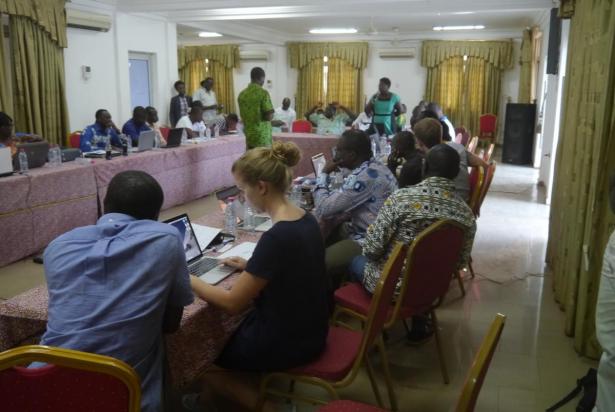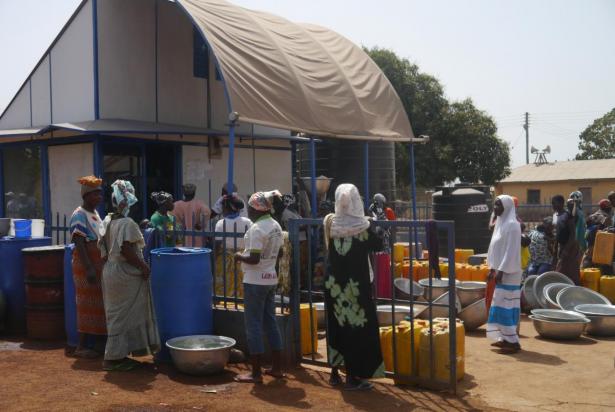The SMARTerWASH initiative in Ghana upgrades ICT tools for continuous monitoring.
Published on: 07/04/2016
The SMARTerWASH initiative by CWSA/IRC has set up an ICT architecture for nationwide and long-term monitoring of WASH services in rural communities and small towns in Ghana. This has been implemented across 119 districts in six regions where baseline data was collected and the capacity of over 700 officials from Metropolitan Municipal and District Assemblies (MMDAs) developed. For a more robust architecture, the ICT tools have now been upgraded and are ready for piloting in three districts - East Gonja, Sunyani West and Wassa East - before nationwide scale-up.
Following the upgrade of the monitoring tools a training workshop to pilot continuous monitoring of water facilities was held in Tamale - the Northern Regional Capital of Ghana from February 8 – 12, 2016. Under the theme, “Training on upgraded ICT Tools for continuous monitoring of Rural and Small Town Water Supply Services by MMDAs to be piloted in three districts”, the workshop focused on preparing the staff of Community Water and Sanitation Agency (CWSA) and the MMDAs of the pilot regions with the requisite skills and knowledge to support the process and to test the designed interoperable ICT architecture. A total of 38 participants, drawn mainly from CWSA and MMDAs of pilot regions and districts, were trained on the use of the upgraded ICT monitoring tools and the designed interoperable ICT architecture. The five-day training, which combined a closed workshop and two days of field-testing in the East Gonja district of the northern region forms part of the preparations towards piloting the monitoring functionality before the nationwide scale up.

The first two days of the training workshop, participants were taken through how to synchronise collected data to the FLOW application; how to filter the data points by name, distance and date; how to find those data points on the integrated map in the FLOW application; and how to treat the data once it has entered the dashboard. On interoperability, how the three (3) systems (DiMES, FLOW and SkyFox SMS) were going to work together; downloading data from FLOW, importing the data into DiMES (Ghana’s national monitoring system), deploying imported data into DiMES and analysing the data were amply demonstrated. It was explained that DiMES at the end of its development should be interoperable with FLOW and the SkyFox systems. The other two days of field-testing were an opportunity for participants to demonstrate their understanding and ability in the application of the FLOW monitoring feature.
Kwasi Owusu Mintah, Planning officer for Sunyani West District Assembly, noted, “The training has really reinforced an existing skill I have on the use of the FLOW; and I believe this one has given me a hands-on and more practical exposure. As a development planner, I believe it will not only help me in planning, but it will also help us in actually assessing results from services provided - whether the available facilities are delivering services or not. When scaled up, it will greatly enhance the work of Assemblies in service monitoring. The challenge, however, is to ensure DiMES come into operation where districts will be using DiMES in their routine work and will own the DiMES and then be able to provide services based on data and feedback they get from the DiMES”.
Bashiru Shahadu, DWD Engineer, East Gonja District Assembly found the training, participation and facilitation very helpul. He stated, “What impressed me the most is the testing of tools in the field, East Gonja District where a lot of issues came up and were taken on board. The challenge may be how the information of the Akvo FLOW can be well communicated within the DiMES. If this works out it will help us in terms of access to comprehensive water and sanitation data in our districts.”
Summing up his observations on the field-testing, one of the trainers, Lars Heemskerk of Akvo stated, “With some pride I can say that the technical part of the monitoring is working quite smoothly. It is easy to filter the data points (names) and (if the map is visible) to locate them. What could improve on the app side is to allow downloadable maps in the application, which could help enumerators to find data points without an internet connection, and to download and store the photo question on the phone. But my main observation on the success of using the monitoring feature with Akvo FLOW has to do with preparation and processes”.

The organisers and project partners were impressed with the training and are looking forward to a successful pilot. Benedict Kubabum, Director of Planning and Investment, on behalf of the Chief Executive of CWSA entreated participants to be committed to the post-workshop activities agreed upon. Indeed the process towards nationwide continuous monitoring of WASH services will largely depend on the commitment of all parties involved.